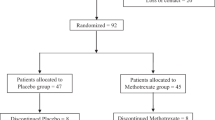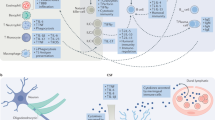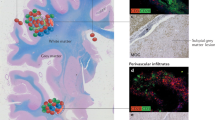Abstract
Schizophrenia is a debilitating, costly, socially disruptive, life-threatening disease in which available treatments are largely palliative and empirical, and produce significant short- and long-term side effects. Therefore, a strong case can made for exploring alternative treatments with a rational basis for use in this disease. Considerable evidence indicates that autoimmune processes may be involved in some forms of schizophrenia, including altered risk of certain autoimmune diseases in patients and their relatives, shared epidemiological features, and apparent involvement of genes known to influence the immune response repertoire. Attempts to provide direct evidence for autoimmune processes have proven elusive, possibly due to the technical difficulty inherent in accessing autoantibodies with high affinity for brain cell-surface receptors. In view of this impasse, we argue for a well-designed trial in schizophrenia of immunosuppressive therapy, which is now the mainstay of therapy for many autoimmune diseases. Analysis of disease states in which immunosuppression has been effectively used over many decades provides guidelines necessary for a meaningful trial.
This is a preview of subscription content, access via your institution
Access options
Subscribe to this journal
Receive 12 print issues and online access
$259.00 per year
only $21.58 per issue
Buy this article
- Purchase on Springer Link
- Instant access to full article PDF
Prices may be subject to local taxes which are calculated during checkout
Similar content being viewed by others
References
Jones P, Barnes T, Davies L, Dunn G, Lloyd H, Hayhurst K et al. Randomized controlled trial of the effect on quality of life of second- vs first-generation antipsychotic drugs in schizophrenia. Arch Gen Psychiatry 2006; 63: 1079–1087.
Eaton W, Byrne M, Ewald H, Mors O, Chen C-Y, Agerbo E et al. Association of schizophrenia and autoimmune diseases: linkage of Danish national registers. Am J Psychiatry 2006; 163: 521–528.
Wright P, Sham P, Gilvarry C, Jones P, Cannon M, Sharma T et al. Autoimmune diseases in the pedigrees of schizophrenic and control subjects. Schizophr Res 1996; 20: 261–267.
Mellsop G, Koadlow L, Syme J, Whittingham S . Absence of rheumatoid arthritis in schizophrenia. Aust NZ J Med 1974; 4: 247–252.
Finney G . Juvenile onset diabetes and schizophrenia? Lancet 1989; ii: 1214–1215.
Tiwari J, Terasaki P . HLA and Disease Associations. Springer-Verlag: New York, 1985.
Knight J, Knight A, Pert C . Is schizophrenia a virally triggered antireceptor autoimmune disease?. In: Helmchen H and Henn F (eds). Biological Perspectives of Schizophrenia. Wiley: Chichester, 1987, pp 107–127.
Knight J . Dopamine-stimulating autoantibodies: a possible cause of schizophrenia. Lancet 1982; ii: 1073–1076.
Mednick S, Machon R, Huttunen M, Bonett D . Adult schizophrenia following prenatal exposure to an influenza epidemic. Arch Gen Psychiatry 1988; 45: 189–192.
O'Callaghan E, Sham P, Takei N, Glover G, Murray R . Schizophrenia after prenatal exposure to 1957 A2 influenza epidemic. Lancet 1991; 1: 1248–1250.
Menninger K . Influenza and schizophrenia. An analysis of post-influenzal dementia praecox as of 1918 and five years later. Am J Psychiatry 1926; 82: 469–529.
Davison K . Organic and toxic concomitants of schizophrenia. In: Helmchen H and Henn F (eds). Biological Perspectives of Schizophrenia. Wiley: Chichester, 1987, pp 139–160.
Turner W, Tsuang M . Impact of substance abuse on the course and outcome of schizophrenia. Schizophr Bull 1990; 16: 87–95.
Kirch D, Kaufmann C, Papadopoulos N, Martin B, Weinberger D . Abnormal cerebrospinal fluid protein indices in schizophrenia. Biol Psychiatry 1985; 20: 1039–1046.
Frohman E, Racke M, Raine C . Multiple sclerosis – the plaque and its pathogenesis. N Engl J Med 2006; 354: 942–955.
Licinio J, Seibyl J, Altemus M, Charney D, Krystal J . Elevated CSF levels of interleukin-2 in neuroleptic-free schizophrenic patients. Am J Psychiatry 1993; 150: 1408–1410.
McAllister C, van Kammen D, Rehn T, Miller A, Gurklis J, Kelley M et al. Increases in CSF levels of interleukin-2 in schizophrenia: effects of recurrence of psychosis and medication status. Am J Psychiatry 1995; 152: 1291–1297.
Ganguli R, Yang Z, Shurin G, Chengappa R, Brar J, Gubbi A et al. Serum interleukin-6 concentration in schizophrenia: elevation associated with duration of illness. Psychiatry Res 1994; 51: 1–10.
McAllister C, Rapaport M, Pickar D, Podruchny T, Christison G, Alphs L et al. Increased numbers of CD5+ B lymphocytes in schizophrenic patients. Arch Gen Psychiatry 1989; 46: 890–894.
Schatz D, Lang F, Cantor A, Riley W, Maclaren N, Sleasman J et al. CD5+ B lymphocytes in high-risk islet cell antibody-positive and newly diagnosed IDDM subjects. Diabetes 1991; 40: 1314–1318.
Wright P, Nimgaonkar V, Donaldson P, Murray R . Schizophrenia and HLA: a review. Schizophr Res 2001; 47: 1–12.
Rudduck C, Beckman L, Franzen G, Jacobsson L, Lindstrom L . Complement factor C4 in schizophrenia. Hum Hered 1985; 35: 223–226.
Lokki M-L, Circolo A, Ahokas P, Rupert K, Yu C, Colten H . Deficiency of Human Complement Protein C4 Due to Identical Frameshift Mutations in the C4A and C4B Genes. J Immunol 1999; 162: 3687–3693.
Thomsen M, Molvig J, Zerbib A, de Preval C, Abbal M, Dugoujon J et al. The susceptibility to insulin-dependent diabetes mellitus is associated with C4 allotypes independently of the association with HLA-DQ alleles in HLA-DR3,4 heterozygotes. Immunogenetics 1988; 28: 320–327.
Field L, Dizier M, Anderson C, Spence M, Rotter J . HLA-dependent Gm effects in insulin-dependent diabetes: evidence from pairs of affected siblings. Am J Hum Genet 1986; 39: 640–647.
Millward B, Welsh K, Leslie R, Pyke D, Demaine A . T cell receptor beta chain polymorphisms are associated with insulin-dependent diabetes. Clin Exp Immunol 1987; 70: 152–157.
Salier J, Sesboue R, Martin-Mondiere C, Daveau M, Cesaro P, Cavelier B et al. Combined influences of Gm and HLA phenotypes upon multiple sclerosis susceptibility and severity. J Clin Invest 1986; 78: 533–538.
Seboun E, Robinson M, Doolittle T, Ciulla T, Kindt T, Hauser S . A susceptibility locus for multiple sclerosis is linked to the T-cell receptor beta chain complex. Cell 1989; 57: 1095–1100.
Zhang W, Cobain T, Dawkins R, Grimsley G, Mackay I . Complement allotyping explains MHC associations in multiple sclerosis. Ann NY Acad Sci 1988; 540: 372–373.
Riley B, Kendler K . Molecular genetic studies of schizophrenia. Eur J Hum Genet 2006; 14: 669–680.
Carter C . Schizophrenia susceptibility genes converge on interlinked pathways related to glutamatergic transmission and long-term potentiation, oxidative stress and oligodendrocyte viability. Schizophr Res 2006; 86: 1–14.
O'Donovan M, Williams N, Owen M . Recent advances in the genetics of schizophrenia. Hum Mol Genet 2003; 12: R125–R133.
Horton R, Wilming L, Rand V, Lovering R, Bruford E, Khodiyar V et al. Gene map of the extended human MHC. Nat Rev Genet 2004; 5: 889–899.
Knight J, Knight A, Ungvari G . Can autoimmune mechanisms account for the genetic predisposition to schizophrenia? Br J Psychiatry 1992; 160: 537–540.
McAllister C, Rapaport M, Pickar D, Paul S . Effects of short-term administration of antipsychotic drugs on lymphocyte subsets in schizophrenic patients. Arch Gen Psychiatry 1989; 46: 956–957.
Maes M, Melzer H, Bosmans E . Immune-inflammatory markers in schizophrenia: comparison to normal controls and effects of clozapine. Acta Psychiatr Scand 1994; 89: 346–351.
Leykin I, Mayer R, Shinitzky M . Short and long term immunosuppressive effects of clozapine and haloperidol. Immunopharmacology 1997; 37: 75–86.
Knight J, Knight A, Menkes D, Mullen P . Autoantibodies against brain septal region antigens specific to unmedicated schizophrenia? Biol Psychiatry 1990; 28: 467–474.
Ling M, Perry P, Tsuang M . Side effects of corticosteroid therapy. Arch Gen Psychiatry 1981; 38: 471–477.
Brunton L, Lazo J, Parker K . Goodman & Gilman's The Pharmacological Basis of Therapeutics. McGraw-Hill: New York, 2006.
Cohn J, Steckler G, Rubinstein J . Effect of cortisone in treatment of psychotic illnesses. J Clin Exp Psychopathol 1953; xiv: 161–175.
Rees L, King G . Intensive cortisone therapy in schizophrenia. J Ment Sci 1956; 102: 155–159.
Polatin P, Lesse S, Harris M . Use of large doses of cortisone in schizophrenia. AMA Arch Neurol Psychiatry 1955; 73: 485–495.
Adams D, Knight J, Manning P, Smith G . An informative case of Graves' disease with implications for schizophrenia. J Clin Lab Immunol 2005; 53: 13–25.
Schulz S, van Kammen D, Waters R, Klein H, Balow J, Bunney W . Double-blind evaluation of plasmapharesis in schizophrenic patients: a pilot study. Artif Organs 1983; 7: 317–321.
Fellerhoff B, Laumbacher B, Wank R . High risk of schizophrenia and other mental disorders associated with chlamydial infections: hypothesis to combine drug treatment and adoptive immunotherapy. Med Hypotheses 2005; 65: 243–252.
Wank R . Schizophrenia and other mental disorders require long-term adoptive immunotherapy. Med Hypotheses 2002; 59: 154–158.
Muller N, Riedel M, Scheppach C, Brandstatter B, Sokullu S, Krampe K et al. Beneficial antipsychotic effects of celecoxib add-on therapy compared to risperidone alone in schizophrenia. Am J Psychiatry 2002; 159: 1029–1034.
Riedel M, Strassnig M, Schwarz M, Muller N . COX-2 inhibitors as adjunctive therapy in schizophrenia: rationale for use and evidence to date. CNS Drugs 2005; 19: 805–819.
Yokota O, Terada S, Ishihara T, Nakashima H, Kugo A, Ujike H et al. Neuronal expression of cyclooxygenase-2, a pro-inflammatory protein, in the hippocampus of patients with schizophrenia. Prog Neuropsychopharmacol Biol Psychiatry 2004; 28: 715–721.
Balow J, Austin H . Maintenance therapy for lupus nephritis – something old, something new. N Engl J Med 2004; 350: 1044–1046.
Pelaia G, Vatrella A, Cuda G, Maselli R . Molecular mechanisms of corticosteroid actions in chronic inflammatory airway disease. Life Sci 2003; 72: 1549–1561.
Welner M . Antipsychotic drugs and interactions: implications for criminal and civil litigation. In: Mozayani A and Raymon L (eds). Handbook of Drug Interactions. Humana Press: Totowa, NJ, 2004.
Baxter K, Stockley I . Stockley's Drug Interactions: A Source Book of Interactions, their Mechanisms, Clinical Importance and Management. Pharmaceutical Press: London, 2006.
Tatro D . Drug Interaction Facts. Wolters Kluwer Health Inc: St Louis, Missouri, 2006.
Drachman D . Myasthenia gravis and other diseases of the neromuscular junction. In: Kasper D (ed). Harrison's Principles of Internal Medicine. McGraw Hill: London, 2005, pp 2518–2523.
Sweetman S . Martindale: The Complete Drug Reference. Pharmaceutical Press: London, 2005.
Johns T . Long term corticosteroid treatment of myasthenia gravis. Ann NY Acad Sci 1987; 505: 568–583.
Werner S, Ingbar S . The Thyroid. Harper and Row: New York, 1975.
Berg S, Poplack D . Treatment of meningeal malignancy. Oncologist 1996; 1: 56–61.
Balis F, Lester C, Chrousos G, Heideman R, Poplack D . Differences in cerebrospinal fluid penetration of corticosteroids: possible relationship to the prevention of meningeal leukemia. J Clin Oncol 1987; 5: 202–207.
Jones B, Freeman A, Shuster J, Jacquillat C, Pochedly C, Sinks L et al. Lower incidence of meningeal leukemia when prednisone is replaced by dexamethasone in the treatment of acute lymphocytic leukemia. Med Pediatr Oncol 1991; 19: 269–275.
Valesini G, Priori R, Francia A, Balestrieri G, Tincani A, Airo P et al. Central nervous system involvement in systemic lupus erythematosus: a new therapeutic approach with intrathecal dexamethasone and methotrexate. Springer Semin Immunopathol 1994; 16: 313–321.
Sanna G, Bertolaccini M, Mathieu A . Central nervous system lupus: a clinical approach to therapy. Lupus 2003; 12: 935–942.
Abbott N, Mendoca L, Dolman D . The blood-brain barrier in systemic lupus erythematosus. Lupus 2003; 12: 908–915.
Ropper A . Selective treatment of multiple sclerosis. N Engl J Med 2006; 354: 965–967.
Al Hadithy A, de Boer N, Derijks L, Escher J, Mulder C, Brouwers J . Thiopurines in inflammatory bowel disease: pharmacogenetics, therapeutic drug monitoring and clinical recommendations. Dig Liver Dis 2005; 37: 228–297.
Author information
Authors and Affiliations
Corresponding author
Rights and permissions
About this article
Cite this article
Knight, J., Menkes, D., Highton, J. et al. Rationale for a trial of immunosuppressive therapy in acute schizophrenia. Mol Psychiatry 12, 424–431 (2007). https://doi.org/10.1038/sj.mp.4001959
Received:
Revised:
Accepted:
Published:
Issue Date:
DOI: https://doi.org/10.1038/sj.mp.4001959
Keywords
This article is cited by
-
Proof-of-concept randomized controlled trial of pregnenolone in schizophrenia
Psychopharmacology (2014)
-
Proof-of-Concept Trial with the Neurosteroid Pregnenolone Targeting Cognitive and Negative Symptoms in Schizophrenia
Neuropsychopharmacology (2009)
-
Autoantibodies against opioid or glutamate receptors are associated with changes in morphine reward and physical dependence in mice
Psychopharmacology (2008)
-
Association analysis of heat shock protein 70 gene polymorphisms in schizophrenia
European Archives of Psychiatry and Clinical Neuroscience (2008)



